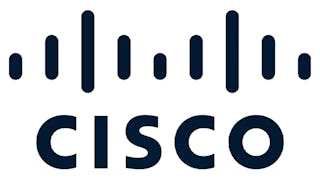Aggressive network traffic can cause serious congestion, disrupting critical applications like voice, video, and interactive services. This course equips you with the expertise to master Cisco’s powerful congestion management and Quality of Service (QoS) tools, ensuring essential applications maintain the performance needed to meet demanding service levels. You’ll learn to configure advanced queuing techniques—including Weighted Fair Queuing (WFQ), Class-Based WFQ, and Low Latency Queuing (LLQ)—and discover how to leverage congestion avoidance strategies such as Random Early Detection (RED), Weighted RED (WRED), and Explicit Congestion Notification (ECN) to minimize packet loss and delay.


Managing Network Traffic with QoS
包含在 中
您将学到什么
Understand hardware and software queuing and how to manage congestion using link efficiency mechanisms to collectively improve bandwidth efficiency
Explain the problems resulting from TCP flow control limitations on a converged network and how RED can prevent congestion in a TCP/IP network
Explain traffic policing and traffic shaping
您将获得的技能
要了解的详细信息

添加到您的领英档案
June 2025
21 项作业
了解顶级公司的员工如何掌握热门技能

积累特定领域的专业知识
- 向行业专家学习新概念
- 获得对主题或工具的基础理解
- 通过实践项目培养工作相关技能
- 获得可共享的职业证书

该课程共有5个模块
涵盖的内容
2篇阅读材料
Aggressive traffic can fill interface queues and starve more fragile flows such as voice, video, and interactive traffic. The results can be devastating for delay-sensitive traffic types, making it difficult to meet the service-level requirements that these applications require. There are many congestion management techniques available on Cisco platforms that can provide you with an effective means to manage software queues and to allocate the required bandwidth to specific applications when congestion exists. Upon completing this learning content, you will be able to: • Describe the functions of hardware and software queuing and various commonly used queuing algorithms. • Configure Weighted Fair Queuing (WFQ) to manage congestion. • Configure Class-Based Weighted Fair Queuing (CBWFQ) and low latency queuing (LLQ) to manage congestion. • Describe campus-based techniques to manage congestion.
涵盖的内容
13篇阅读材料5个作业
Congestion is a normal occurrence in networks. Whether congestion occurs as a result of a lack of buffer space, network aggregation points, or a low-speed wide-area link, many congestion management techniques exist to ensure that specific applications and traffic classes are given their share of available bandwidth when congestion occurs. When congestion occurs, some traffic is delayed or even dropped at the expense of other traffic. When drops occur, different problems may arise that can exacerbate the congestion, such as retransmissions and TCP global synchronization in TCP/IP networks. Network administrators can use congestion avoidance mechanisms to reduce the negative effects of congestion by penalizing the most aggressive traffic streams as software queues begin to fill.
涵盖的内容
12篇阅读材料5个作业
Different forms of connectivity within a network can have significantly different costs for an organization. Because WAN bandwidth is relatively expensive, many organizations would like to limit the amount of traffic that specific applications can send. This is especially true when enterprise networks use internet connections for connectivity to remote sites and the extranet. Downloading nonbusiness-critical images, music, and movie files can significantly reduce the amount of bandwidth that is available for mission-critical applications. Traffic policing and traffic shaping are two quality of service (QoS) techniques that can limit the amount of bandwidth that a specific application, user, or class of traffic can use on a link. Upon completing this course, you will be able to: • Explain how traffic policing and traffic shaping can be used to rate-limit traffic. • Configure class-based policing to rate-limit traffic. • Describe the implementation options that are available for traffic policing in the campus. • Configure class-based shaping to rate-limit traffic. • Given a Frame Relay WAN link, configure class-based shaping to rate-limit traffic. • Given a Frame Relay WAN link, configure the Frame Relay Voice-Adaptive Traffic Shaping and Fragmentation feature to improve the performance of voice transport.
涵盖的内容
23篇阅读材料7个作业
In a network that consists of a large WAN covering many sites, the monthly recurring cost of even the smallest link upgrade can be too high. In some cases, the only option for low-bandwidth remote sites is to upgrade their wide-area circuit. In other cases, a set of quality of service (QoS) techniques can be used to improve the efficiency of these low-speed WAN links, which, in this context, typically refer to links with speeds less than or equal to 768 kb/s. Header compression and payload compression mechanisms reduce the sizes of packets, reducing delay and increasing available bandwidth on a link. Other QoS link efficiency techniques, such as link fragmentation and interleaving (LFI), allow fragile traffic types, such as voice and interactive traffic, to be sent either ahead or interleaved with larger, more aggressive flows. These techniques decrease latency and assist in meeting the service-level requirements of delay-sensitive traffic types such as voice.
涵盖的内容
11篇阅读材料4个作业
获得职业证书
将此证书添加到您的 LinkedIn 个人资料、简历或履历中。在社交媒体和绩效考核中分享。
位教师

从 Networking 浏览更多内容
 状态:免费试用
状态:免费试用Cisco Learning and Certifications
 状态:免费试用
状态:免费试用Cisco Learning and Certifications
 状态:免费试用
状态:免费试用Cisco Learning and Certifications
 状态:免费试用
状态:免费试用Cisco Learning and Certifications
人们为什么选择 Coursera 来帮助自己实现职业发展




常见问题
To access the course materials, assignments and to earn a Certificate, you will need to purchase the Certificate experience when you enroll in a course. You can try a Free Trial instead, or apply for Financial Aid. The course may offer 'Full Course, No Certificate' instead. This option lets you see all course materials, submit required assessments, and get a final grade. This also means that you will not be able to purchase a Certificate experience.
When you enroll in the course, you get access to all of the courses in the Specialization, and you earn a certificate when you complete the work. Your electronic Certificate will be added to your Accomplishments page - from there, you can print your Certificate or add it to your LinkedIn profile.
Yes. In select learning programs, you can apply for financial aid or a scholarship if you can’t afford the enrollment fee. If fin aid or scholarship is available for your learning program selection, you’ll find a link to apply on the description page.
更多问题
提供助学金,



